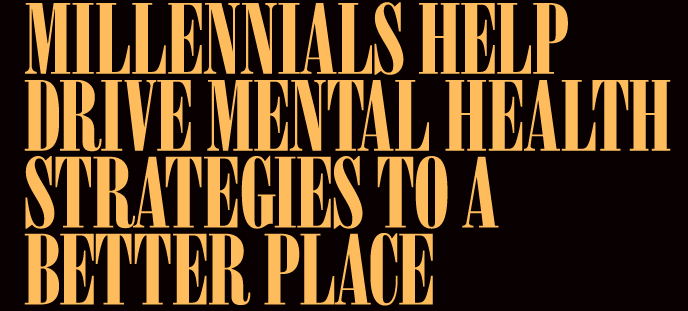By Terri L. Rhodes
Millennials comprise more than one-third of the U.S. labor force and are the largest generation currently in the workplace. Much attention has been paid to the recruitment and retention of millennials, who often bring different expectations and needs, including work/life balance expectations.
Employers have also learned millennials bring something else to work: a heightened emphasis on mental health. Part of this could be higher incidences of mental health issues among this generation. For example, a 2018 report from the Blue Cross Blue Shield Association found a 47% increase between 2013 and 2016 in depression diagnoses among 18- to 34-year olds. In the same year, the American Psychiatric Association, based on poll results, dubbed Millennials the most “anxious generation.”
But another part of the equation is an increased awareness of and willingness to openly discuss mental health among Millennials and younger generations. Depression, anxiety, and eating disorders are all illnesses portrayed in the media. Celebrities such as Demi Lovato, Lady Gaga, and Dwayne “the Rock” Johnson have publicly discussed their struggles with depression. Many therapists also credit social media — often criticized as a source of millennial distress — with helping to normalize mental illness. Vix Meldrew, 32, a London blogger, says that whenever she talks about mental health online, her response from readers skyrockets because she is “making them feel less alone.”
Surveys indicate this has resulted in less stigma about mental health among millennials. This, in turn, is reflected in greater willingness to consult with therapists among millennials and college students. Many younger people pursue therapy as another form of self-improvement and personal growth, not unlike yoga or meditation. According to a 2017 report from the Center for Collegiate Mental Health at Penn State University, which compiled data from 147 colleges and universities, the number of students seeking mental health help significantly increased from 2011 to 2016.
More than the generations before them, millennials acknowledge mental health issues, will talk about them, and will seek help to address them. At work, that means seeking assistance and support from their employers. Many organizations are not prepared for this changing reality. According to The Standard’s 2017 Disability Leave Survey, less than one-third of HR decision makers feel very confident accommodating behavioral health conditions. Far too often, there is still stigma attached to mental illness among those who have been in the workforce for a longer period of time.
The result can be less treatment and reduced performance, including more absence and disability. According to The Standard’s 2017 survey, those with mental health issues are on leave for an average of 112 days. This compares to 59 days for those without mental health issues. In addition, unaddressed mental health issues often give rise to behavioral health issues like drug abuse. This can lead to yet more absence and disability. Finally, there is legal and regulatory risk, with laws like the Americans with Disabilities Act (ADA) and the Family and Medical Leave Act (FMLA) that encompass these issues.
An effective workplace health strategy that includes mental health support and assistance starts with a proactive program of education and communication. To this end, there are a number of steps — often costing nothing — that employers can implement to better promote and support the mental health of their workforce, particularly millennials. These include:
Actively Eliminate Stigma. Millennials are widely credited as the generation shattering workplace stigmas associated with mental health. Thus, a work culture that passively tolerates stigmas can amplify feelings of conflict for millennials, which can be a hindrance to their full participation and successful re-engagement after an absence. There are a number of steps to eliminating stigma.
First, dispel myths about mental illness. Those who suffer from it are no more likely to be violent, able to overcome it by “toughing it out,” or embody any other of the long-standing mental health myths propagated in popular culture.
Second, discourage stigmatizing language. No more talk of someone being “crazy,” or saying, “this job is so tough it makes me want to kill myself.” We wouldn’t speak this way about cancer or heart disease. Illness is illness.
Third, offer and regularly communicate about an employee assistance program (EAP) and health insurance benefits. This includes offering resources and materials about mental and behavioral health. What we see and hear regularly is what we come to know as normal.
Finally, executives can use clear and direct language in support of addressing these issues. Support from the top has an enormous impact on culture and attitudes about what is acceptable in any organization.
Strategically Target Key Triggers
There is no single solution for addressing mental health in the workplace, including the most common condition, stress. But there are key triggers for all employees, including millennials. For example, worries about money — financial wellness — are a major factor impacting employee performance. In a recent study by a financial wellness company, 36% of millennials showed symptoms related to post-traumatic stress disorder due to financial stress.
Another trigger is adequate time off to help care for family. Millennials certainly have children. They also have aging parents and other relatives. This stressor trigger is increasingly addressed through family leave programs, including paid leave.
Offering targeted programs like a financial wellness or family leave program can help augment an organization’s larger mental health strategy. These programs also have the added benefit of communicating an organization’s commitment to work-life balance, an important factor in attracting and retaining millennial employees.
Stay in Touch
Keep an open connection with employees while they are on leave to help mitigate additional stress. A lack of communication can be interpreted as stigmatization. Additionally, returning to work and finding they are behind the learning curve on significant organizational initiatives or changes can be very stressful. This is particularly important for millennials who, as a generation, are used to having unlimited access to an endless stream of information via texts and social media. Losing that connection to the workplace can be a major source of stress.
It’s important to make sure any communication with employees on leave complies with the FMLA and other laws and respects an employee’s desires as to the extent of communication, and with whom.
Support Return to Work
The overwhelming majority of people with a mental health issue experience recovery. So if an illness results in leave or even disability, an ill employee is likely to return to work. Communicate openly regarding the return-to-work process. Ensuring that employees know they have a supportive pathway back to the workplace facilitates return-to-work efforts.
It also can also help promote stay-at-work initiatives. That’s critical, especially with millennials. As noted above, these employees place a high value on connection and inclusion. Programs designed to help employees keep working and contributing — even while they suffer from stress, anxiety or other mental health issues — improves morale and facilitates recovery.
Fostering a workplace that recognizes millennials’ mental health expectations and experiences is a good way to attract and retain these employees. But it does a great deal more. Reducing stigma and increasing access to care for all employees moves organizations toward a prevention and early treatment model. Just as with physical health, over time that lowers costs and risk. That’s good for every employee and stakeholder.

Terri L. Rhodes is CEO of the Disability Management Employer Coalition. Rhodes was an Absence and Disability Management Consultant for Mercer, and also served as Director of Absence and Disability for Health Net and Corporate IDM Program Manager for Abbott Laboratories.

